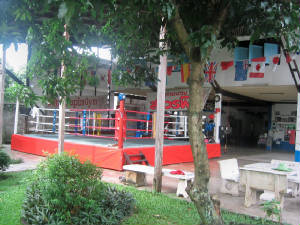|
The Story of Nai Khanomtom
by Panya Kratius & Dr. Pitisuk Kraitus
At
the time of the fall of the ancient Thai capital of Ayuthya in 1767, when the city was destablized and heading ofr destruction
because it rulers were weak, the invading Burmese troops rounded up a group of Thai residents and took them as prisoners.
Among them were a large number of Thai boxers, who were held by the Burmese potentate Suki Phra Nai Kong of Kai Pho Sam Ton
at the city of Ungwa.
In 1774, On the Day of March 17, in the Burmese city of Rangoon, the Lord Mangra, king of the
Burmese, decided to organize a seven-day, seven-night celebration in honor of the pagoda where the Buddha's relics are preserved.
He ordered a royal presentation of a Thai boxing match between Thai and Burmese fighters. For the celebration, he also arranged
for several folk-type spectacles such as the costume plays called likay, comedies and farces, and sword-fighting matches.
The boxing ring was set up in front of the throne.
During the first day of the celebration, a high-ranking Burmese
nobleman led a Thai boxer to pay his respects to the Burmese king. Lord Mangra then agreed to allow a Burmese boxer to pit
his strength against that of the Thai boxer. A referee led the Thai boxer into the ring and introduced his as Nai Khanom Tom,
a famous fighter from Ayuthya, a viewers saw a robust, dogged dark-skinned captive. Among the group of Burmese spectators
was a group of Thai captives who view sitting with each other, cheering him.
As soon as he matched with a fighter,
Nai Khanom Tom began dancing around his opponent, which amazed and perplexed the Burmese spectators. The referee then announced
that the dance was a Thai tradition (wai khruu) through which the boxer paid his respects to his mentor.
Then the
signal for the match was given, Nai Khanom Tom rushed forward, elbowing and pummeling his opponent in the chest until the
latter collapsed. The referee, however, judged that the knockout was not to be considered a victory for th eThai boxer, since
his Burmese opponent had been distracted by the wai khruu dance, so Nai Khanom Tom had to confront nine other Burmese boxers.
This decision prompted the other Thai boxers to volunteer to fight together with Nai Khanom Tom to avenge him.
Nai
Khanom Tom agreed to fight against the other Burmese boxers to uphold the reputation of Thai boxing. His last opponent was
in fact a boxing teacher from Ya Kai City who was on a visit to enjoy the festivities. Thus, he volunteered to fight, but
was soon so mangled by Nai Khanom Tom's kicks that no one dared to challenge him further.
However, Lord Mangra was
so enthralled with Thai boxing that he summoned Nai Khanom Tom to reward him, asking which he would prefer, money or beauteous
wives. Without hesitation, Nai Khanom Tom said he would take the wives, because money was easier to find. So Lord Mangra awarded
him two Burmese girls from the Mon tribe. In time, Nai Khamon Tom took his lovely wives to Thailand, where he lived with them
until the end of his life.
He is considered the first Thai boxer to have imprinted the art of Thai boxing with dignity,
and who gave it such a reputation beyond Thailand's borders that the episode remains engraved in the history of Burma until
this day.
Nai Khanomtom is also known as the "father" or "inventor" of Muay Thai and the day of March 17 is known as "Muay Thai
Day".

MUAY THAI CULTURE
Wai Khru / Ram Muay
Wai Khru / Ram Muay is a ceremony performed by Muay Thai
fighters before each and every competition in the ring. It is a dance ritual used to show respect to their teachers, parents
and everything they hold sacred as well as a method of praying for victory and safety.
Wai
Khru Ram Muay is an ancient ritual passed down from generation to generation. During ancient times, Siamese soldiers would
perform this ceremony before going to war using their weapon of choice as a way to gather courage and healthy spirit.
Nowadays,
it is performed in the ring of traditional Muay Thai bouts. Each individual camp possesses their own Wai Khru / Ram Muay.
Mongkhon
The
Mongkhon is an essential possession of every true Nak Muay (Thai Boxer). The Mongkhon is basically a
round band worn around the head of the boxer to bring good luck, success and prosperity to him/her. Another tradition descended
from ancient times; the Mongkhon originates from Siamese soldiers tying lucky bandanas around their heads before going
into battle.
The
Mongkhon is placed on the head of the fighter by the teacher or a relative or loved one before each fight in the ring.
It is removed after the Wai Khru / Ram Muay by the teacher as a small
prayer is shared between fighter and teacher before the fight.
Prajiat
The
Prajiat, much like the Mongkhon, is another essential element in Muay Thai culture. The Prajiat is a
small band worn around the biceps of the fighter to increase confidence, avoid danger, injury or fatality. The Prajiat
is kept on the fighter throughout the fight
These
traditional customs of Muay Thai are taken into serious account by all authentic camps. Where some camps may see them as cultural
byproducts of the art, others believe that spirits have blessed these items and by wearing the Mongkhon, the Prajiat
and performing the Wai Khru / Ram Muay, it empowers them almost to the point of invicibility. Although these beliefs
may seem untrue to most, embracing this optimism before each fight would certainly be beneficial.
|

